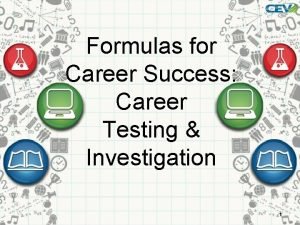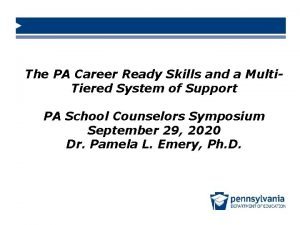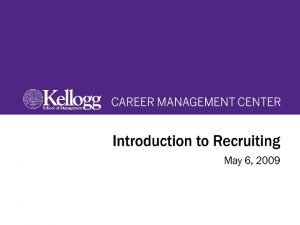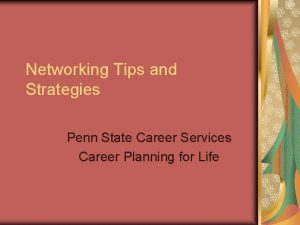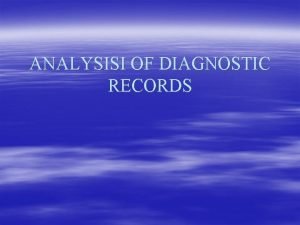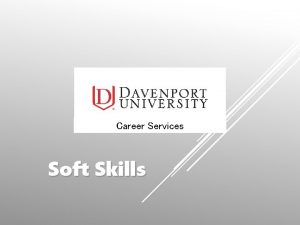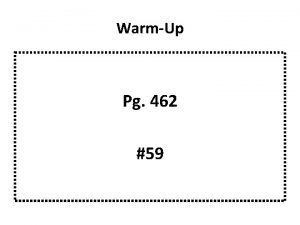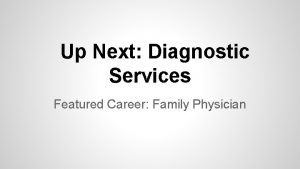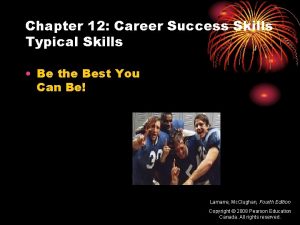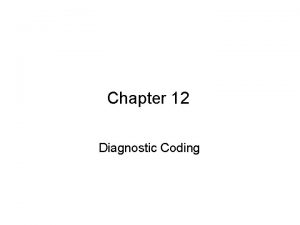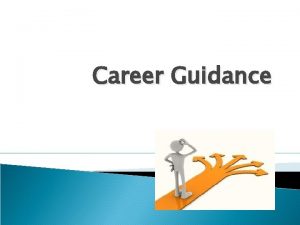Chapter 10 Career Skills in Diagnostic Services WarmUp


























- Slides: 26


Chapter 10 Career Skills in Diagnostic Services

Warm-Up • Think about a time when you or someone you know had to visit a healthcare facility for an injury. • What types of tests did healthcare professionals use to diagnose the injury? A and N photography/Shutterstock. com Copyright Goodheart-Willcox Co. , Inc. May not be posted to a publicly accessible website.

Diagnostic Services Pathway • Diagnostic services workers help determine diagnoses through clinical tests and medical imaging • Includes some work with hearing and vision tests • May interact with machines more than patients Tyler Olson/Shutterstock. com Copyright Goodheart-Willcox Co. , Inc. May not be posted to a publicly accessible website.

Personal Traits for Diagnostic Services • • • An interest in working “behind the scenes” An interest in operating machines The ability to work accurately and reliably The ability to follow detailed instructions and organize data in precise ways The ability to remain calm and focused in stressful situations A willingness to admit mistakes and correct errors A problem-solving mindset Stamina to work on your feet Commitment to lifelong learning Michal Kowalski/Shutterstock. com Copyright Goodheart-Willcox Co. , Inc. May not be posted to a publicly accessible website.

Critical Thinking The graphic shows some common careers in diagnostic services. Which of these careers interests you the most? What education and training is required for that job? Copyright Goodheart-Willcox Co. , Inc. May not be posted to a publicly accessible website.

Clinical Laboratory Careers • Workers at a clinical laboratory – Draw blood and receive specimens for testing – Examine and analyze body fluids and cells • In a clinic, a medical assistant or a phlebotomist draws the blood sample • Patients may not see the medical lab technician or medical technologist who examines the specimen 4774344 sean/i. Stock/Thinkstock Copyright Goodheart-Willcox Co. , Inc. May not be posted to a publicly accessible website.

Lab Technologists and Technicians • Lab technologists – Also called medical technologists or clinical laboratory scientists – Use microscopes, cell counters, other specialized laboratory equipment • Lab technicians – Perform less complex tests and procedures – May prepare specimens, operate automated analyzers, and perform manual tests under supervision • Use protective equipment, infection control, and sterilization Air Images/Shutterstock. com Copyright Goodheart-Willcox Co. , Inc. May not be posted to a publicly accessible website.

Think Further What changes in healthcare have caused lab workers to be in high demand? • Rapid point-of-care tests, which lab workers often perform, are now available in many different settings. • Genetic testing is becoming more common and lab workers perform these tests. • Public health laboratories in every state need specialists to analyze complex problems affecting public health, including environmental health concerns and disease detection. Copyright Goodheart-Willcox Co. , Inc. May not be posted to a publicly accessible website.

Medical Imaging Careers • Medical imaging produces images of the body for use in diagnosing medical problems • Radiographers (radiologic technicians) – Produce X-ray images of the human body • Radiologic technologists – Perform more complex imaging procedures than radiologic technicians • Radiation therapist – Uses a treatment plan to deliver radiation treatment for cancer • Sonographer – Use sound waves to generate an image Cessna 152/Shutterstock. com Copyright Goodheart-Willcox Co. , Inc. May not be posted to a publicly accessible website.

Vision- and Hearing-Related Careers • Ophthalmologist – Eye specialist • Otolaryngologist – Ear specialist • Optometrist – Performs routine vision testing and correction • Audiologist – Assesses patient’s hearing disorders and develop treatment plans Copyright Goodheart-Willcox Co. , Inc. May not be posted to a publicly accessible website.

Healthcare Team Interaction • Delegating tasks – Tasks must be delegated according to scope of practice • Sharing information – Guided by a healthcare worker’s scope of practice – Must follow guidelines of the HIPAA Privacy Rule • Building team relationships – Be positive – Be sensitive – Be respectful of differences michaeljung/Shutterstock. com Copyright Goodheart-Willcox Co. , Inc. May not be posted to a publicly accessible website.

Think Further When might you refuse a task that has been delegated to you by a superior? • The task is illegal or unethical. • The task is outside your scope of practice. • You can’t perform the task safely because of a lack of directions, equipment, or supervision. • You have not been trained for the task. • The task is not a part of your job description. Copyright Goodheart-Willcox Co. , Inc. May not be posted to a publicly accessible website.

Technical Skills for Diagnostic Workers • Measuring vital signs – Temperature • Different thermometers and methods – Pulse • Count the number of beats in one minute – Respiration • Count a patient’s breaths in one minute – Blood pressure • Sphygmomanometer bikeriderlondon/Shutterstock. com Copyright Goodheart-Willcox Co. , Inc. May not be posted to a publicly accessible website.

Measuring Height and Weight • Not considered vital signs, but measured periodically to provide information about overall health • Different types of scales • Follow specific steps to measure height and weight, depending on the scale you’re using • Some patients (those in a wheelchair or confined to bed) are special cases AVAVA/Shutterstock. com Copyright Goodheart-Willcox Co. , Inc. May not be posted to a publicly accessible website.

Critical Thinking What tools do you need when measuring vital signs? Role play the proper procedures with a partner, if possible. • • Thermometer (oral, rectal, axillary, tympanic/temporal) Stethoscope (used to measure apical pulse) Watch (used to measure pulse and respirations) Sphygmomanometer (mercury, aneroid, digital) Height and weight are not vital signs. Why is getting this information so important to patient health? • Increased weight can indicate retention of fluid, which is common in heart and kidney disease. • Unexplained weight loss can signal disease. • Changes in weight may require a change in medication dosage. Copyright Goodheart-Willcox Co. , Inc. May not be posted to a publicly accessible website.

Positioning a Patient • Specific body positions required for imaging – – – Supine/dorsal recumbent position Fowler’s position Prone position Sim’s position Lateral/lateral recumbent position Sim’s position • Body alignment – Spine is not twisted or crooked – Use pillows to provide comfort and maintain alignment Body Scientific International, LLC Fowler’s position Lateral/Lateral Recumbent Position Copyright Goodheart-Willcox Co. , Inc. May not be posted to a publicly accessible website.

Screening Vision and Hearing • Children in schools are frequently screened for – Visual acuity • Nearsightedness (myopia) • Farsightedness (hyperopia) – Hearing loss • Uses an audiometer • Tests are performed twice with a week between them • Temporary hearing loss may be due to a cold or other infection • Refer child to a medical professional to determine cause of hearing loss Hung Chih/Shutterstock. com Copyright Goodheart-Willcox Co. , Inc. May not be posted to a publicly accessible website.

Providing First Aid • All healthcare workers can and should seek first aid training • Cardiopulmonary resuscitation • Using an automated external defibrillator (AED) • Treating a choking victim • Checking an injured or ill adult • Understand your scope of practice in emergencies Lisa F. Young/Shutterstock. com Copyright Goodheart-Willcox Co. , Inc. May not be posted to a publicly accessible website.

Emergency First Aid Procedures • Cardiopulmonary resuscitation (CPR): supplies oxygen to brain and organs until medical help arrives • Automated external defibrillator (AED): delivers an electric shock to the heart to restore normal rhythm • Clearing airway obstructions: 5 back blows followed by 5 abdominal thrusts William Perugini/Shutterstock. com Copyright Goodheart-Willcox Co. , Inc. May not be posted to a publicly accessible website.

Critical Thinking List situations that might require emergency first aid. Examples: • • • Cardiac emergencies Breathing emergencies Sudden illness Environmental emergencies Soft tissue injuries Muscle, bone, and joint injuries stefanolunardi/Shutterstock. com Copyright Goodheart-Willcox Co. , Inc. May not be posted to a publicly accessible website.

Checking an Injured Adult • Perform ABC check – Airway is clear – Breathing is ok – Circulation (look for severe bleeding) • Call 911 immediately if you see these problems – Unconsciousness – Trouble breathing – No breathing or movement – Severe bleeding Photographee. eu/Shutterstock. com Copyright Goodheart-Willcox Co. , Inc. May not be posted to a publicly accessible website.

Think Further • What training will you complete to be prepared for a medical emergency? • Where in your community can you complete emergency first aid training? Lisa F. Young/Shutterstock. com Copyright Goodheart-Willcox Co. , Inc. May not be posted to a publicly accessible website.

Employability Skills for Healthcare Workers • Succeeding on the job – Be on time – Dress appropriately – Learn names – Listen closely – Follow instructions – Work hard and be productive michaeljung/Shutterstock. com Copyright Goodheart-Willcox Co. , Inc. May not be posted to a publicly accessible website.

Following Professional Standards • • • Work within your scope of practice Use correct, approved methods for all procedures Seek proper authorization for all procedures Address patients by name Obtain patient consent Maintain confidentiality Provide high-quality care at all times to everyone Report errors to your supervisor immediately Stay calm Act with integrity Copyright Goodheart-Willcox Co. , Inc. May not be posted to a publicly accessible website.

Understanding Your Paycheck • Gross pay vs. net pay • Federal Insurance Contributions Act (FICA) • Federal withholding tax Copyright Goodheart-Willcox Co. , Inc. May not be posted to a publicly accessible website.
 Warmup ratio
Warmup ratio Warmup 65
Warmup 65 Gmass warmup
Gmass warmup Stratified warmup
Stratified warmup Surface area warm up
Surface area warm up Monorhyme
Monorhyme Multiplying with exponents
Multiplying with exponents Java warmup
Java warmup Define:warmup
Define:warmup Persuasive essay quotes
Persuasive essay quotes Tinman warmup
Tinman warmup Warmup 65
Warmup 65 Warmup end
Warmup end Health informatics jobs
Health informatics jobs Remote desktop services diagnostic tool
Remote desktop services diagnostic tool Diagnostic services careers
Diagnostic services careers 16 national career clusters
16 national career clusters Formulas for career success: résumés - assessment
Formulas for career success: résumés - assessment Pa career ready skills
Pa career ready skills Career 1 stop.org
Career 1 stop.org Life and career skills
Life and career skills Skills for health career framework
Skills for health career framework Chapter 6 career readiness chapter review
Chapter 6 career readiness chapter review Cmc kellogg
Cmc kellogg Wake forest opcd
Wake forest opcd Career services penn state harrisburg
Career services penn state harrisburg 5 health care career pathways
5 health care career pathways

















